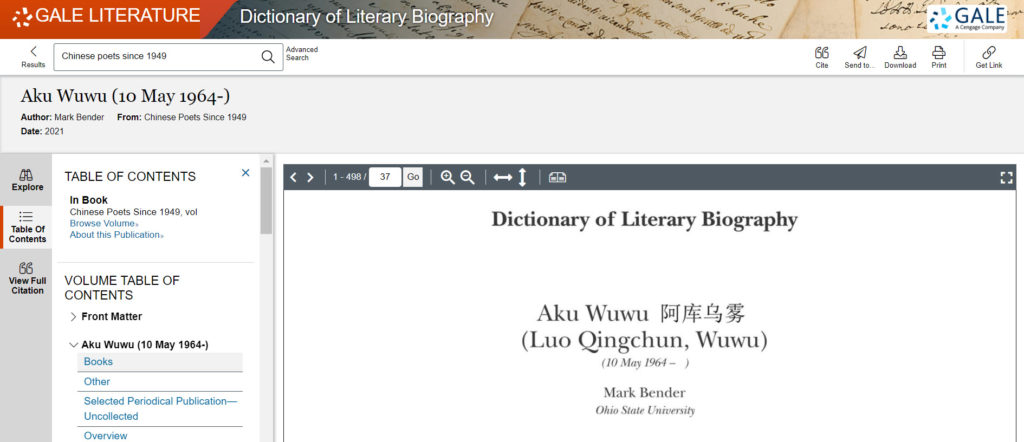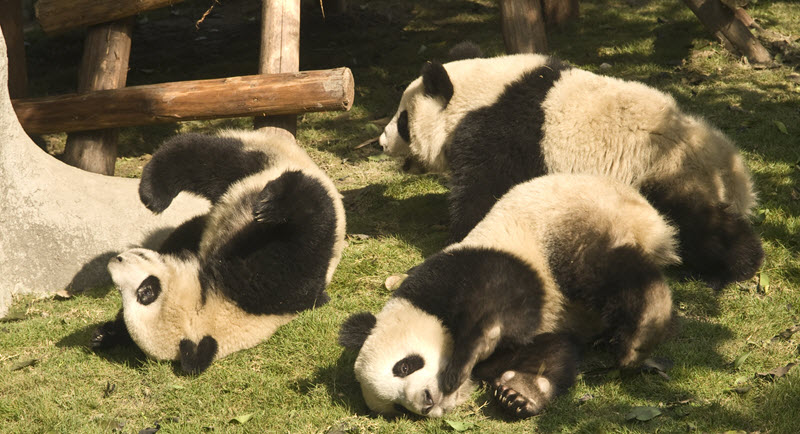| By Rebecca Parks |
When my brother went to China on vacation a couple years ago, he brought me back a beautiful miniature black-lacquered paneled screen as a souvenir. He had to look long and hard for a screen that did NOT include pandas on it, knowing I would object to something so clichéd. Apparently, these items are marketed heavily to the tourist trade, and most tourists want pandas. After all, what says “China” to the Western visitor more than cuddly, bamboo-eating black-and-white bears?
And that’s not an unjustified association. I listened to a 2019 report from Public Radio International through the Gale Literature Resource Center database the other day that talked about China’s ownership of the world’s pandas—not just the 1,800+ living in their natural habitat in a few mountain ranges in south-central China, but also the approximately 500 pandas on loan to zoos throughout the world and any babies that are born through captive breeding programs. Apparently, zoos pay annual rental fees of up to $1 million to China for panda pairs in 10-year increments; if a baby is born from that pair, the zoo pays an additional $400,000 fee AND China gets to take the baby back at four years old for its domestic breeding program. I have clearly gone into the wrong business; panda rentals are the way to go.
Pandas aren’t just a lucrative export for China; they also serve as the world’s cutest diplomatic pawns, with favored nations getting the privilege of hosting pandas. China has also been known to take back pandas if they are displeased. For example, when U.S. president Barack Obama met with the Dalai Lama over China’s objections in February 2010, China repatriated two pandas from U.S. zoos. When it comes to ursine trade wars, China is holding all the cards.
So why am I reading about China’s panda monopoly? Because I really didn’t want to read about all the other China-related news that’s been churning in 2020: coronavirus outbreak origin stories/conspiracies, the sparring between U.S. president Donald Trump and Beijing over tariffs and unfair trade practices, and even the backlash by Chinese fans over the comments by BTS frontman RM about the Korean War, which they interpreted as slighting the Chinese losses in the same conflict. When it comes to news about China in the American press, I very rarely hear anything positive.
When enough negative news piles up, I find myself buried beneath it, struggling for the air that will clear my mind of the suffocating social construct of China as some monolithic “other,” a convenient super-villain with the agenda that always runs counter to mine—or at least to my country’s. For the super-villain narrative to work, however, China has to be portrayed with black-and-white clarity as defined as the panda itself, erasing nuances, shadings, and the diversity that is natural to humanity. That’s not cute, and it’s not accurate, even if it does serve the purpose of a 500-word article. Accurately portraying the real culture, the real person, the real country, the real anything requires the reader to look deeper.
Take, for example, the recent publication of Gale’s Dictionary of Literary Biography, volume 387, on Chinese poets since 1949, which is available in print as well as database form through Gale Literature: Dictionary of Literary Biography. The year 1949 marks the beginning of the People’s Republic of China as the climax of the Communist Revolution. It would be easy to paint Chinese poetry from this period with the broad brush of conformity to state control in service to the Communist agenda. Yet, reading through this volume, I’m astonished at the diversity of viewpoints, directly contradicting the rigid uniformity that is an unfortunate stereotype of China.

The volume covers 45 major contemporary poets from the mainland as well as Hong Kong and Taiwan, composed by the leading scholars currently writing in English on modern Chinese poetry. The amazing spectrum includes poets such as Shi Zhi (b. 1948) who was one of the few to publicly produce poetry during the Cultural Revolution while carefully navigating Mao Zedong’s strict definition of culturally appropriate literature. Other mainland poets, such as Ji Xian (1913-2013), a leader of the Chinese modernist movement, refused to conform, traveling to Taiwan, where he founded the premier modernist publication Xiandai shi (Modern Poetry), which was unabashedly anti-Communist.
With the end of the Cultural Revolution in 1976 and relaxing of restrictions, a generation of youth would begin an avant-garde post-Mao poetry movement known as Menglong shi (misty or obscure poetry), a term initially considered pejorative but later embraced. This volume includes the stories of these poets, such as Bei Dao (b. 1949), who initially started writing poetry to distract himself from the monotony and despair of his life while being “reeducated” in the countryside, and who would go on to start the influential underground journal Jintian (Today). Several Jintian poets were part of the Cultural Revolution’s program to send urban educated youth to the countryside to work as manual laborers, including Mang Ke (b. 1950) and Yang Lian (b. 1955).
The Third Generation poets who came after the Jintian poets wrote from a much different experience than their predecessors, although their style was also avant-garde. Major figures such as Haizi (1964-1989), Xi Chuan (b. 1963), and Lan Lan (b. 1967) came of age in a time when the cultural climate was not as restrictive; young poets were exposed to Western literature in China’s universities and benefited from the greater freedom in society. Their complex, sophisticated syntactic structures and discordant imagery stood in contrast to the Minjian shige (poetry of the people or poetry from the people) typified by the poets Yu Jian (b. 1954) and Han Dong (b. 1961), who preferred to write more accessible poetry that could be easily understood and appreciated by anyone.
In reading these biographies, I see the individuals within the larger movements: their poetic innovations, their artistic achievements, their unique career paths, their struggles, the ways they sought to define themselves as individuals in a society undergoing seismic change, the degree to which they conformed or rebelled against outside attempts to define them. Their stories are inspiring, illuminating, and sometimes heartbreaking—unique yet together providing a picture of Chinese cultural achievement in the same way that individual threads are woven together to create a colorful silk tapestry.
But, please, no pandas on my tapestry.


